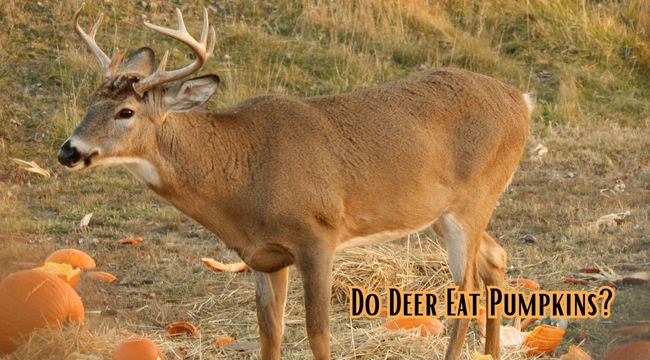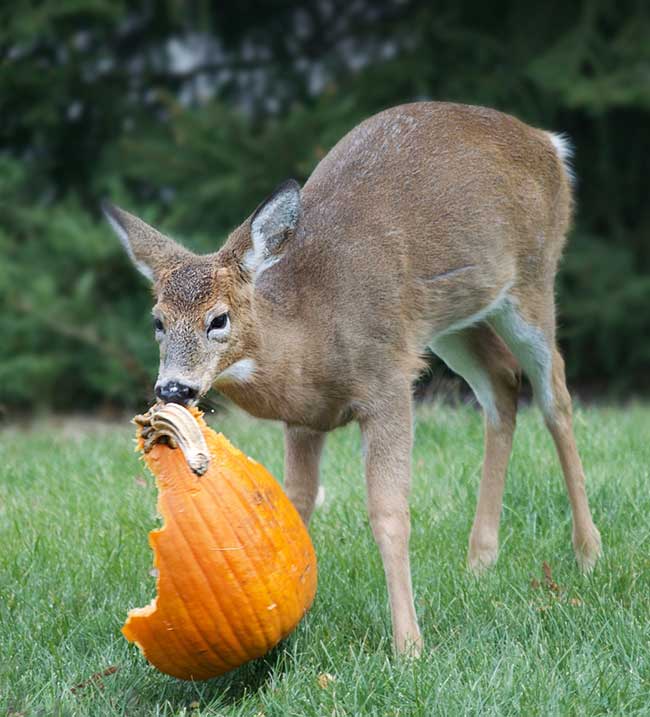
Are you a pumpkin grower who’s ever woken up to find your prized pumpkins smashed or missing? If so, you might be wondering whether deer are responsible. As herbivores, deer are known to enjoy a variety of plant-based foods, but do they really eat pumpkins? In this blog post, we’ll take a closer look at the question “Do deer eat pumpkins?” and provide you with the answers you need to protect your crops. Whether you’re a farmer, gardener, or simply curious about wildlife, read on to discover the truth about deer and pumpkins.
Does Deer Eat Pumpkins?
Yes, deer do eat pumpkins. In fact, they seem to enjoy every part of the pumpkin – the leaves, seeds, flesh, and skin. Even pumpkin blossoms, which have a strong scent that attracts deer, are a delicacy to them. This makes pumpkins a highly desirable food source for deer, and can be a major problem for farmers and gardeners trying to grow them.
If you suspect that deer are responsible for the damage to your pumpkins, here are some steps you can take to confirm your suspicions:
- Check for deer droppings: Look for small, round or oval pellets of dark brown or black colors near your pumpkins or the surrounding areas. These droppings are a telltale sign that deer have been in the area.
- Look for deer footprints: Deer hooves have a unique shape, with convex sides and front tips that face towards the inside of the track. The footprints typically resemble an upside-down broken heart shape. Check the ground around your pumpkins for these distinctive tracks.
- Examine your pumpkins: If a deer has been eating your pumpkins, you may find that whole pumpkins have been consumed, or that the pumpkins have been crushed. This could be due to deer accidentally stepping on them or trying to get to the flesh inside.
By following these steps, you can determine whether or not deer are responsible for the damage to your pumpkins. If you do find evidence of deer, there are various measures you can take to protect your pumpkins, such as using deer repellents, erecting barriers, or using motion-activated sprinklers to scare them away.
What Other Animals Eat Pumpkins? A Look at Some of the Common Pumpkin-Eating Creatures

While deer are known to be fond of pumpkins, they are not the only animals that enjoy this tasty fruit. Here are a few other animals that may eat pumpkins:
- Squirrels: Squirrels are known to eat a variety of fruits and vegetables, and pumpkins are no exception. They may gnaw on the outer skin to get at the flesh inside or consume pumpkin seeds.
- Raccoons: These omnivorous creatures are opportunistic eaters and will consume a wide variety of foods, including pumpkins. They may also tear into the fruit to get at the flesh inside.
- Chipmunks: Similar to squirrels, chipmunks enjoy a varied diet and may nibble on pumpkin flesh or seeds.
- Birds: Certain species of birds, such as crows and blue jays, have been known to peck at pumpkins to get at the seeds inside.
- Rodents: Other rodents, such as mice and rats, may also be attracted to pumpkins and may gnaw on them to get at the flesh inside.
While these animals may not cause as much damage to pumpkins as deer, they can still be a nuisance for gardeners and homeowners trying to grow their own pumpkins. To protect your pumpkins from these animals, you may need to use physical barriers or repellents designed specifically for the animal in question.
Is It Okay To Feed Pumpkin to Deer? Understanding the Risks and Benefits
Deer may love pumpkins, but it is not recommended to feed them. As wild animals, deer should not become dependent on humans for food. Wildlife organizations discourage people from feeding deer because it can greatly harm their population in the long term.
Although it may be tempting to feed deer due to their adorable appearance and hunger, it can have negative consequences. Deer may become more accustomed to people and urban areas, and constantly return to them, leading to groups of deer traveling in areas where they would not naturally be found. This can increase their risk of being hit or killed by cars, especially at night when their vision is not optimized for looking at headlights.
Additionally, feeding deer can lead to the spread of diseases among the population. If one deer gets sick and others follow it to the feeding area, the disease can rapidly spread and harm the entire population.
Feeding wild animals has led to the extinction of some deer species, and some countries have even legally forbidden people from feeding deer. Therefore, while it may be tempting to feed deer, it is best to let them find their own food and maintain their natural habitat.
The Nutritional Value of Pumpkins for Deer
Pumpkins are not only a favorite food of humans during the fall season but also a healthy snack for deer. Research shows that pumpkins are a rich source of nutrients that can help keep deer healthy. The fiber content of pumpkins helps to strengthen the bones of deer, while the Vitamin C and potassium contents contribute to overall health. Additionally, different parts of the pumpkin provide varying nutritional values. The guts contain large amounts of fiber, while the pumpkin seeds are rich sources of omega-6 fats, which are essential nutrients during harsh winters when food is usually scarce.
The Attraction of Pumpkins to Deer
Deer are attracted to pumpkins, both the plants and the fruit. The scent of pumpkin plants draws them in, and they enjoy feeding on fresh pumpkin leaves. During the summer, deer can often be found in pumpkin fields. However, pumpkins are not their top favorite food, and they have a variety of other foods they prefer, such as corn, acorns, beans, grass, and cultivated vegetables like sweet potatoes and rye.
If a deer is not eating pumpkins, it may be because it is in starvation mode and will eat anything it can find. Alternatively, there may be an abundance of other foods available that the deer finds more appealing, such as corn. While pumpkins are not the most preferred food for deer, they still enjoy them and can benefit from the nutrients they provide, including fiber, vitamin C, and potassium.


